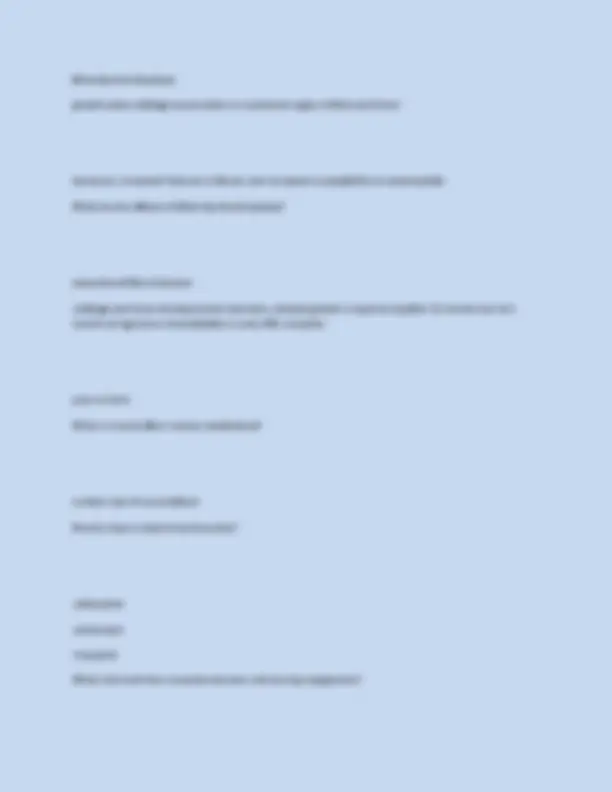


















Study with the several resources on Docsity

Earn points by helping other students or get them with a premium plan


Prepare for your exams
Study with the several resources on Docsity

Earn points to download
Earn points by helping other students or get them with a premium plan
Community
Ask the community for help and clear up your study doubts
Discover the best universities in your country according to Docsity users
Free resources
Download our free guides on studying techniques, anxiety management strategies, and thesis advice from Docsity tutors
AVS 4110 Exam 1COASTAL AND ESTEUARINE ECOLOGY 2025-2026 EXAM QUESTIONS AND COMPLETE CORRECT ANSWERS.
Typology: Exams
1 / 24

This page cannot be seen from the preview
Don't miss anything!

















growth
general and normal expansion of size as produced by the accretion of tissues similar in composition to that of the original tissue or organ
true growth
increase in structural tissues: bone, muscle, and connective tissue
development
gradual progression from lower to higher state of complexity
sigmoidal shape
What is the shape of the growth curve?
before and after birth
When does slow growth occur?
What are the qualities of the growth of bone tissue?
What are the qualities of the growth of muscle tissue?
hyperplasia
increase in cell number
hypertrophy
increase in cell size
factors of skeletal muscle tissue
longissimus
the largest muscle of domestic animals; accounts for 10% of total muscle weight
What is the anatomy of muscle?
I-band
region which only contains thin filaments; isotropic; light band
A-band
length of thick filament and contains thin filament that overlaps the thick filament; anisotropic; dark band
h-zone
region where only thick filament is present
m-line
center of thick filament
z-line
center of thin filament
they contain few cells (fibroblasts, mast cells, macrophages in a large intercellular matrix of both inorganic (bone and organic substances which are non-living
How is connective tissue different from other tissues?
What is the role of connective tissue?
intercellular matrix
composed of mucopolysaccharides, chrondrotin sulfates, and byaluronic acid set in framework of elastin and collagen fibers
What are the characteristics of loose connective tissue?
What is the role of loose connective tissue?
What are the two types of bone?
hard bone
Which type of bone is the shaft of long bones?
spongy bone
Which type of bone is the vertebrae, flat bones, or end of long bones?
epiphysis
enlarged ends of bone
diaphysis
shaft region of bone
medullary cavity
bone marrow
adipocytes
found in perimysial space, accumulation near blood vessels
marbling
intramuscular fat; fat within the muscle
zygote --> morula --> blastocyst
What is the proper order of the differentiation of tissues during prenatal growth and development?
What are the 3 stages of embryo development?
11 to 14 days
How long is the germinal phase?
rapid cell division (cleavage
What is the germinal phase characterized by?
germinal phase
The following refer to which stage of embryo development:
What are the 3 stages that occur during the embryonic phase of embryo development?
gastrulation
Which stage of the embryonic phase includes the following:
ectoderm
outermost cell layer, ultimately forms the skin and neuronal tissues
mesoderm
middle cell layer, develop into muscle, fat, and bone
endoderm
innermost cell layer, develops into tissues of respiratory and digestive tract
neuralation
event during development that results in the formation of spinal cord PRECURSORS; neural tube is formed
the peripheral nerves are formed
What happens once the neural tube is formed and CLOSED during neuralation?
sclerotome
form vertebral column
fetal phase
point where species ID can be established onward
What are the characteristcs of the fetal phase during embryonic development?
totipotent stem cells
can form any cell type in the body, plus extra-embryonic or placental cells
within the first couple of divisions after fertilization
When can totipotent stem cells form embryonic cells?
pluripotent stem cells
can give rise to all cell types of body; embryonic stem cells
multipotent stem cells
can develop into more than one cell type; adult stem cells and cord blood cells
unipotent stem cells
develop into only one cell type
What are the three main functions of bone?
matrix, minerals
30% of bone is ___________, and 70% is composed of _____________.
What are the four bone cell types?
What are the two osteogenic pathways?
intramembrous ossification
The following process describes what?
begins in utero during fetal development, continues into adolescence
When does intramembrous ossification occur?
at birth, skull and clavicles are not fully ossified so that they are ale to deform during passage through the birth canal
What role does intramembrous ossification play in birth?
endochondral ossification
bone develops by replacing hyaline cartilage
chondrocytes
cartilage cells that form the cartilaginous skeletal precursor of the bones
perichondrium
a membrane that covers the cartilage then appears
primary ossification center
a region deep in the periosteal collar where ossification begins
avascular
Cartilage is _____________, meaning there are no blood vessels supplying nutrients or removing metabolic wastes.
epiphyseal plate
area of growth in a long bone; layer of hyaline cartilage where ossification occurs in immature bones
cartilage is formed
What occurs on the epiphyseal side of the epiphyseal plate?
epiphyseal closure
fusion of the epiphyses and diaphysis into a single bone
maturity in lamb carcasses
Growth plate closure determines what?
break joint
epiphyseal cartilage breaks = less than a year
spool joint
epiphyseal cartilage ossified and foot separates = over a year
buttons
cartilaginous ends of the thoracic vertebrae
low blood Calcium
release of PTH which stimulates osteoclast activity and corresponding resorption of bone calcium
high blood calcium
thyroid gland release calcitonin; stimulates osteoblast activity with a corresponding deposition of calcium into bone
stimulate proliferation of chondrocytes
What is the role of IGF-1?
estrogen receptors
pubertal growth spurt and cessation of growth are induced by sex hormones
What are the factors that control cartilage maturation?
extracellular matrix proteins
critical for proper differentiation and organization of growth plate chondrocytes
fibroblastic growth factor receptors
presence of this halts proliferation of epiphyseal growth plate cells; instructs cartilage precursors to differentiate